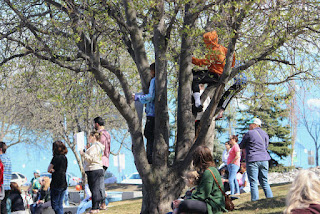It seems to me there have been several issues raised, that the judge(s) will have to rule on. [Note: when I use district numbers, I'm using numbers from the November plan, because those are the ones that were used through the court hearings and it's less confusing.]
1. Does the newest map (and basically we're only looking at four Senate districts at this point) meet the constitutional standards?
This would seem cut and dried, and probably is. But perhaps not. Here's what the Alaska Constitution says:
§ 6. District Boundaries
The Redistricting Board shall establish the size and area of house districts, subject to the limitations of this article. Each house district shall be formed of contiguous and compact territory containing as nearly as practicable a relatively integrated socio-economic area. Each shall contain a population as near as practicable to the quotient obtained by dividing the population of the state by forty. Each senate district shall be composed as near as practicable of two contiguous house districts. Consideration may be given to local government boundaries. Drainage and other geographic features shall be used in describing boundaries wherever possible.
The Court has at points been pretty clear that if the boundaries of two house districts are touching, then they meet the contiguity requirement. And while the majority Board members used anecdotes to show their new districts are Socio-Economically Integrated (SEI), that is not one of the criteria. Neither is compactness. But 'communities of interest' is a term that has been mentioned, and 'equal protection'' is also a factor in Senate seats. (For example Judge Thomas Matthews decision pp.31-34 and again on 53-55)
On page 28, Matthews also wrote:
"The Alaska supreme Court has defined a “contiguous territory” as one which is bordering or touching. The Court determined that “[a] district may be defined as contiguous if every part of the district is reachable form [sic] every other part without crossing the district boundary (i.e., the district is not divided into two or more discrete pieces of land)."
In practical terms. HD 22 and HD 9 could be considered two discrete pieces of land. Except by hiking across miles of unpopulated mountains and valleys, you cannot get from one part of the new Senate district without crossing the district boundary. Yet that is also the case for the Valdez and Matsu pairing which both the Superior and Supreme Court said was constitutional.
And while people have argued that 'practicable' should mean that an impassable boundary through the mountains isn't practicable, the other side pointed to court case language that said having to drive through other districts is not a problem. The new Senate [House] district that both Courts approved, pairing Valdez and Mat-Su is a case in point.
I would argue that in an urban area where there are plenty of much easier boundaries to cross, the courts have left a giant loophole for Boards that want to gerrymander. And the Board's majority walked right through that loophole.
In fact Judge Thomas Matthews quotes from the proceedings of the Constitutional Convention that the Redistricting criteria were meant to make it harder to gerrymander.
“Addressing the appropriate method of drawing districts, the framers believed that the redistricting criteria of compactness, contiguity, and socio-economic integration were necessary to prevent gerrymandering. The purpose of utilizing watershed boundaries was to keep communities intact, whereas roads cutting through communities should not serve as boundaries.” [From Thomas Matthews' decision p. 132]
It would seem that this little paragraph offers a lot to attorneys who want to mine it to argue why the 3B boundaries are bad.
- the criterion of contiguity as used here assists gerrymandering, it doesn't prevent it
- the joining of people across watershed boundaries unites people not naturally a unit instead of uniting those within those boundaries
- Eagle River's two districts are divided by boundaries that cut through roads. Pairing them would repair rather than exacerbate this use of roads cutting through communities serving as boundaries
Making the kind of boundary in the new Senate Seat that combines HD 22 and HD7, that runs through the mountains and makes residents cross multiple House boundaries to actually get to the other House District in their Senate seat, makes a mockery of the purpose of contiguity and invites the odd pairing that we get in this case. Which helps people who want to gerrymander.
At the Supreme Court hearing on the 2021 plan, Justice Warren Matthews asked if the Board's attorney, Matt Singer, was saying that the ruling that all parts of a borough are SEI means that the Court couldn't rule that there was gerrymandering in Anchorage? The judge did acknowledge that there were different neighborhoods with different interests within the Anchorage bowl.
I'd also point out that the Court has endorsed different standards for compactness and deviation for rural and urban districts. It's easier, in areas with high population density, to create more compact districts and districts with lower deviations. I would argue that the courts should breathe life into the words "as near as practicable" in urban areas.
Ultimately, I think the most likely possibility of contiguity playing a role in overturning the Senate pairings, is if contiguity is just one of many other pieces of evidence that points to political gerrymandering.
2. Is the final plan the result of partisan gerrymandering?
This would seem the more likely reason for the Courts to overturn the final map. In the next week I will flesh out this section. For now let me outline the kinds of evidence that could be used to demonstrate that gerrymandering is what happened.
A. The results of the new map - NOT pairing the two Eagle River house seats results in an extra Republican seat in the Alaska Senate. It also pits two Republican incumbents against each other - both of whom have not cooperated with the Governor as much as he would like.
B. The makeup and track record of the Board majority that voted for this map over the vocal opposition of the other two members. Not only were these Board members chosen - unconstitutionally because they were Republicans - they are also actively involved in Republican party politics and on the side of the Governor within the party. Both the Superior Court and the Supreme Court have found them guilty of political gerrymandering already in the first map, and so there is already a track record. Furthermore, the map that was approved was drawn by long time Republican redistricting strategist and former State Republican Party leader Randy Ruedrich. There is no more partisan player in Alaska. And then you can compare the majority to the two minority Board members who were appointed by people not affiliated with any party and have no past history of party activities.
The majority Board members also adopted - in November - a plan for determining rotation of Senate seats that mainly favored Republicans who supported the Governor and punished those who didn't. While the Board members involved insisted they had no idea who the incumbents of the seats were, it has since come out that they had the names from Randy Ruedrich who had apparently devised the plan. They did this insisting it was random. When the minority members said, "If it's random, then let's switch the order." The majority refused. It wasn't random.
C. An objective look at the two proposed maps shows that Option 2 made perfectly natural pairings of House Districts. The proponents of Option 3B (the one chosen) had to use the most twisted logic to justify the maps, an indication that the reasons they did use were simply cover for the real reason they wanted these pairings - gerrymandering.
D. The decision-making process used by the majority was a sham. Judge Thomas Matthews pointed out in his remand order, that the Board members were not subject matter experts on Redistricting. Unlike a Board with doctors or engineers who have subject matter expertise, the Redistricting Board members were essentially lay persons. While they did hire area experts for the mapping and for working the census data, and also to review the VRA implications, they did not hire decision making experts to help them determine what was the best pairing of Senate seats.
That is not to say that they couldn't have done this reasonably themselves. But they never ever made even an attempt to impartially compare the alternative pairings available to them: HD 22 and HD 24 versus HD 22 and HD 9. Instead, they declared HD 24 off limits and only used anecdotal and unverified assertions to justify what they wanted (pairing HD 24 with HD 23 and HD22 with HD 9) and to disparage what they didn't want (pairing HD 23 with HD 17). This was not an objective decision making process. This was the justification of what they had already decided on. And that was pairing D24 with D23 to create an extra Republican Senate seat. I've covered this at length here.
E. Public testimony was strongly in favor of Option 2. Testimony for Option 3B was mostly canned phrases while testimony for Option 2 were more personal explanations of why people preferred Option 2 over Option 3B - The Board's attorney argued in the Supreme Court that weighing public testimony would turn Redistricting into a political process where parties would rally their forces to show up to testify. That did happen. The Republican Board members Singer represented did have their allies rally the Republicans troops. I've preliminarily reviewed the comments. Most of the comments in favor of Option 3B fall into three sets of comments that are virtually the same. One set - "I support Option 3B" was sent in by about 40 people. Another set had about 20 or 30 examples.
The point of Judge Thomas Matthews' comments about public testimony was not that the Board should count the comments and then do what the majority 'voted' for, as Singer argued, but rather was for the Board to hear the concerns of the people and take them into consideration as they created their maps. Then in their explanation of their decision they could explain why certain requests were not followed. But the Board majority did what their attorney warned about - treated the public testimony as a vote. When a slew of testimony came in the first day favoring the Bahnke testimony (which was Option 1 and paired the key Senate districts the same way that Option 2 did) then the Republican party sent out emails and social media messages and drummed up testimony that specifically said "I oppose the Bahnke plan". There was even call-in testimony from Fairbanks saying they opposed the Bahnke plan but that they really didn't know anything about it so they couldn't answer any questions.
Detailed comments - pages long with very specific data that countered the majority Board members' assertions and preferred plan - were ignored. Such clearly reasoned and fact based testimony was the noticeable exception for Option 3B. Testimony by the sitting Senators in the districts involved was ignored. Testimony by former Senators in the district involved was ignored. Well, not totally ignored. They twisted that testimony to 'prove' their decision wasn't partisan gerrymandering. Only testimony that favored their predetermined pairings was attended to.
F. The Board listened to what the courts said about how they were supposed to act. They adopted the appearance of following the courts' orders, but only to cover up their actual intentions. While I covered some of these issues in the points above - things do overlap - I think this is another key point. The Courts need to see through the facade of following the Court's orders and of false justifications that merely mask the actual intent - in this case gerrymandering to garner another Republican Senate seat.
G. Do modern communications technologies make contiguity moot? This point was argued to downplay the distance between Eagle River and Girdwood and Whittier. People no longer need to drive the long distances, they argued, because we now can meet via zoom. People can talk to their Senator by phone or meet with them and others via Zoom. Perhaps this should be in the contiguity sections because it came up in those debates. I have several observations:
- There's a significant difference between online participation and in-person participation. In person you get to talk to the Senator or Representative one-on-one before and after a meeting. You can also talk with other participants, exchange contact info, form bonds, and connect human being to human being. That's much harder online and is much less likely to happen.
- Not everyone has reliable, good enough internet service for meeting this way to be viable.
- People argued this only because the Board created an Anchorage borough Senate seat that stretches the distance of the Borough - 87 miles several people testified - and so this argument came up to say it didn't matter. Not because it doesn't matter, but to bolster the ridiculous pairing of HD22 and HD9 rather than natural pairing of HD 22 and 24. If we can substitute online meetings for in person meetings as they claimed, then the criteria of compactness and contiguity could be dropped altogether. One could argue that certain people who live far apart are communities of shared interest and should be allowed to form House and Senate districts.
One of the people who argued that the various online meeting technologies made the need for geographic proximity moot was Randy Ruedrich. He made that argument while physically present at the Anchorage Legislative Information Office. Walking is a little hard for him these days, yet he made the effort to be at most meetings in person, not online. Because being there in person does matter.
Conclusions
I expected that there would be a lot of gaps, and there clearly is room for filling in details. For example in this post I haven't discussed how the majority insists that Senate Seat L is a holy union of military interests and that pairing JBER with downtown is sacrilegious. Even though the Board must have already committed such sacrilege by creating House District 23, which has already paired most of JBER with a big chunk of downtown. There are many more such examples of duplicity in the Board majority's arguments. Many of those details are in previous posts. But I did a better job than I expected of outlining the key points that need to be made to prove gerrymandering.
While it's possible the Board members' emails will show something more explicit, the circumstantial evidence of gerrymandering is overwhelming. The Board majority put on a show to develop arguments that fit member Budd Simpson's definition of reasonable: "Reasonable means they had a reason." A show for the Court that they were following the Court's orders. Presenting reasons that were factually or logically faulty, or as I argued in the previous post, that bits of facts were wrapped up in lies, didn't matter to them.
I will try to add more detail in future posts to further support the points I've raised. And I'll add links to previous posts. But consider this an executive summary that these additional posts will refer to and add evidence for.
Anyone who has immediate needs for examples and details, just email me and I'll try to help you out.



































